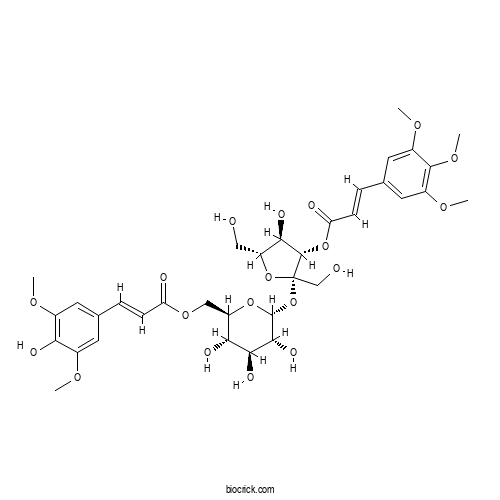Tenuifoliose CCAS# 139682-03-4 |

Quality Control & MSDS
Package In Stock
Number of papers citing our products

| Cas No. | 139682-03-4 | SDF | Download SDF |
| PubChem ID | N/A | Appearance | Powder |
| Formula | C58H72O33 | M.Wt | 1297.3 |
| Type of Compound | N/A | Storage | Desiccate at -20°C |
| Solubility | Soluble in Chloroform,Dichloromethane,Ethyl Acetate,DMSO,Acetone,etc. | ||
| General tips | For obtaining a higher solubility , please warm the tube at 37 ℃ and shake it in the ultrasonic bath for a while.Stock solution can be stored below -20℃ for several months. We recommend that you prepare and use the solution on the same day. However, if the test schedule requires, the stock solutions can be prepared in advance, and the stock solution must be sealed and stored below -20℃. In general, the stock solution can be kept for several months. Before use, we recommend that you leave the vial at room temperature for at least an hour before opening it. |
||
| About Packaging | 1. The packaging of the product may be reversed during transportation, cause the high purity compounds to adhere to the neck or cap of the vial.Take the vail out of its packaging and shake gently until the compounds fall to the bottom of the vial. 2. For liquid products, please centrifuge at 500xg to gather the liquid to the bottom of the vial. 3. Try to avoid loss or contamination during the experiment. |
||
| Shipping Condition | Packaging according to customer requirements(5mg, 10mg, 20mg and more). Ship via FedEx, DHL, UPS, EMS or other couriers with RT, or blue ice upon request. | ||

Tenuifoliose C Dilution Calculator

Tenuifoliose C Molarity Calculator
| 1 mg | 5 mg | 10 mg | 20 mg | 25 mg | |
| 1 mM | 0.7708 mL | 3.8542 mL | 7.7083 mL | 15.4166 mL | 19.2708 mL |
| 5 mM | 0.1542 mL | 0.7708 mL | 1.5417 mL | 3.0833 mL | 3.8542 mL |
| 10 mM | 0.0771 mL | 0.3854 mL | 0.7708 mL | 1.5417 mL | 1.9271 mL |
| 50 mM | 0.0154 mL | 0.0771 mL | 0.1542 mL | 0.3083 mL | 0.3854 mL |
| 100 mM | 0.0077 mL | 0.0385 mL | 0.0771 mL | 0.1542 mL | 0.1927 mL |
| * Note: If you are in the process of experiment, it's necessary to make the dilution ratios of the samples. The dilution data above is only for reference. Normally, it's can get a better solubility within lower of Concentrations. | |||||

Calcutta University

University of Minnesota

University of Maryland School of Medicine

University of Illinois at Chicago

The Ohio State University

University of Zurich

Harvard University

Colorado State University

Auburn University

Yale University

Worcester Polytechnic Institute

Washington State University

Stanford University

University of Leipzig

Universidade da Beira Interior

The Institute of Cancer Research

Heidelberg University

University of Amsterdam

University of Auckland

TsingHua University

The University of Michigan

Miami University

DRURY University

Jilin University

Fudan University

Wuhan University

Sun Yat-sen University

Universite de Paris

Deemed University

Auckland University

The University of Tokyo

Korea University
- α-Cadinol
Catalog No.:BCX2019
CAS No.:481-34-5
- Tenuifoliose K
Catalog No.:BCX2018
CAS No.:147742-16-3
- Tenuifoliose J
Catalog No.:BCX2017
CAS No.:147742-14-1
- Tenuifoliose B
Catalog No.:BCX2016
CAS No.:139682-02-3
- Heteroclitin F
Catalog No.:BCX2015
CAS No.:144049-67-2
- Benzoyloxokadsuranol
Catalog No.:BCX2013
CAS No.:130252-47-0
- Ananonin A
Catalog No.:BCX2012
CAS No.:1314021-67-4
- 5,8-Dihydroxy-6,7,3′,4′-tetramethoxyflavone
Catalog No.:BCX2011
CAS No.:683278-67-3
- 2,5-Dihydroxy-7-methoxyflavanone
Catalog No.:BCX2010
CAS No.:35486-66-9
- 17β-Tenacigenin B
Catalog No.:BCX2009
CAS No.:863767-79-7
- (-)-Torreyol
Catalog No.:BCX2008
CAS No.:19435-97-3
- (-)-cis-Calamenene
Catalog No.:BCX2007
CAS No.:483-77-2
- Binankadsurin A
Catalog No.:BCX2021
CAS No.:77165-79-8
- Ananonin B
Catalog No.:BCX2022
CAS No.:1314021-69-6
- Catechin 7,3'-di-O-beta-D-glucopyranoside
Catalog No.:BCX2023
CAS No.:105330-53-8
- Lansiumamide B
Catalog No.:BCX2024
CAS No.:121817-37-6
- 5-(alpha-D-galactopyranosyl-(1→6)-alpha-D-galactopyranosyloxymethyl)-2-furancarboxaldehyde
Catalog No.:BCX2025
CAS No.:1454574-91-4
- 5-(alpha-D-galactopyranosyloxymethyl)-2-furancarboxaldehyde
Catalog No.:BCX2026
CAS No.:890652-72-9
- Lansiumamide C
Catalog No.:BCX2027
CAS No.:121817-38-7
- Isorhamnetin-3-O-glucosyl-(1->4)-O-rhamnoside
Catalog No.:BCX2028
CAS No.:1135753-17-1
- 5-[(alpha-D-galactopyranosyloxy)methyl]-1H-pyrrole-2-carbaldehyde
Catalog No.:BCX2029
CAS No.:1377977-55-3
- Multinoside A
Catalog No.:BCX2030
CAS No.:59262-54-3
- Clausemarin A
Catalog No.:BCX2031
CAS No.:1609166-45-1
- Isobaisseoside
Catalog No.:BCX2032
CAS No.:167782-21-0
[UPLC/Q-TOF MS and NMR plant metabolomics approach in studying the effect of growth year on the quality of Polygala tenuifolia].[Pubmed:26118115]
Yao Xue Xue Bao. 2015 Mar;50(3):340-7.
Growth year is one of the important factors for the quality of Polygala tenufolia. In this study, primary metabolites and secondary metabolites were compared in 1, 2 and 3 years old P. tenufolia cultivated in Shaanxi Heyang. The samples were subjected to ultra-high performance liquid chromatography (UPLC)-quadrupole time-of-flight mass spectrometry (Q-TOF MS) and nuclear magnetic resonance (NMR) analysis, and the obtained data were analyzed using principal component analysis (PCA) and other statistical analysis methods. In addition, content and correlation of different metabolites were also calculated. The results showed no significance between main component contents in 2 year-old and 3 year-old P. Tenufolia, but 1 year-old was statistically different. The contents of primary metabolites, such as fructose, sucrose, and choline increased as time goes on, while glycine and raffinose decreased. The contents of secondary metabolites, such as onjisaponin Fg, polygalasaponin XXVIII, polygalasaponin XXXII increased, while polygalaxanthone III and parts of oligosaccharide multi-ester including tenuifoliose A, Tenuifoliose C, Tenuifoliose C2 and tenuifoliose H decreased with the extension of the growth years. Growth years has important impact on the quality of P. tenuifolia and the existing growing years of commodity P. tenuifolia have its scientific evidence. This study supplied a new method for the quality evaluation of Chinese medicinal materials.


